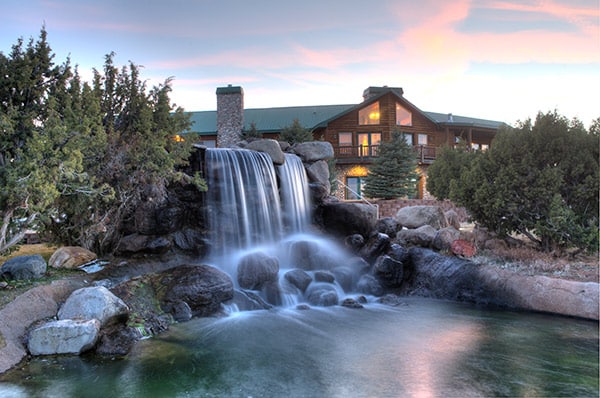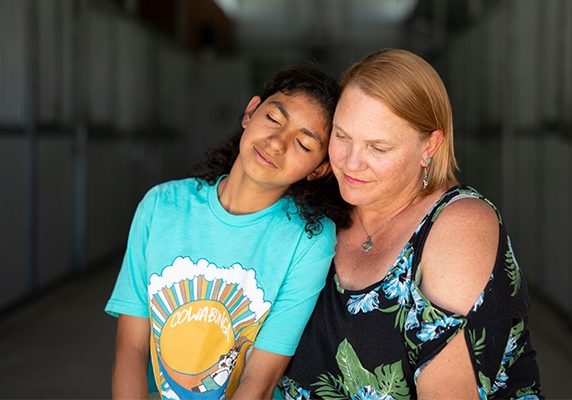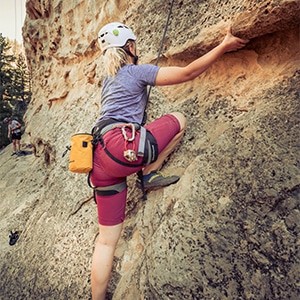Discovery Ranch South provides individualized treatment for teens in recovery from eating disorders, including:
- Anorexia Nervosa
- Bulimia Nervosa
- Binge Eating Disorder
- Orthorexia
- Avoidant/Restrictive Food Intake Disorder (ARFID)
- Other Specified Feeding or Eating Disorders (OSFED)
- Body Image-Related Struggles
- Other Disorded Eating Behaviors
- Eating Disorders & Co-occurring Disorders, including:
- Anxiety and Eating Disorders
- Depression and Eating Disorders
- Trauma and Eating Disorders
- ADHD and Eating Disorders
- Autism and Eating Disorders
- Substance Abuse and Eating Disorders
Does Your Teen Need Eating Disorder Treatment? Learn Who Can Benefit from Our Program
If your teenager is struggling with an eating disorder, we understand the challenges you may be facing as a parent. Depending on the severity of their condition, they may require more medical support than what is available at a traditional residential treatment center. At Discovery Ranch South, we provide adolescent eating disorder treatment for teenagers who meet certain criteria:
- Medical stability: Your teen should be medically stable to the extent that intravenous fluids, nasogastric tube feedings, or multiple daily laboratory tests are not needed. We prioritize their physical health and well-being.
- Body weight: Your teen's body weight should be at or above 85% of the healthy range.
- Desire and motivation to recover: It's important for your teen to have some level of motivation and willingness to engage in the recovery process. Our team at Discovery Ranch South is here to support and empower them on their journey to healing.
- Cooperation with treatment: Your teen should be willing to participate in a highly structured treatment program and cooperate with our team. We provide a supportive and compassionate environment where they can feel safe and respected.
- Use of cognitive and behavioral skills: Your teen should be able to ask for and use support from others, as well as utilize cognitive and behavioral skills to inhibit purging behaviors. We provide evidence-based therapies to help them further develop these coping strategies.
- Need for external structure: Your teen may require external structure beyond self-control to prevent compulsive exercising. Our program at Discovery Ranch South offers a structured environment to help them establish healthy routines.
- Meal supervision: If your teen needs supervision at meals or is at risk of restricting meals, our team can provide the necessary support and monitoring to ensure they receive proper nutrition.
Benefits of Eating Disorder Treatment for Teens
Our eating disorder treatment at Discovery Ranch South offers a range of benefits for your teenager. With personalized care and expert guidance from licensed therapists and mental health professionals, your teenager can develop effective strategies to manage their eating disorder symptoms and thrive in various aspects of their life.
Eating disorder treatment brings many benefits to both teens and their families. These benefits include:
Your teenager's eating disorder should not define their life or prevent them from living a fulfilling life. With our eating disorder treatment program, you can provide your teenager with the necessary tools to manage their symptoms, thrive, and achieve lasting recovery.
Choosing the Right Treatment for Teen Eating Disorder Recovery
Navigating through the different options for teen eating disorder treatment can be overwhelming, but finding a treatment center that offers the right care for your teenager is crucial. At Discovery Ranch South's Residential Treatment Center, we recognize that every family has a unique set of experiences, strengths, and treatment goals. That's why we offer a personalized program that's tailored to meet your specific needs.
Our residential program offers round-the-clock care in scenic lodges that provide a comfortable and home-like environment. Our individualized approach is informed by the latest research on eating disorders and incorporates a variety of therapeutic modalities to provide the best care possible for your teenager's recovery.
Our residential program provides a safe and nurturing environment for your teen to work on developing coping and processing skills through personalized treatment plans and therapeutic interventions led by our experienced staff. Our ultimate goal is to empower them to address their eating disorder challenges and live a life that is full of success and fulfillment.

You Are Not Alone
Discovery Ranch South is there for you and your family.
How We Treat Teenage Eating Disorders

As a parent, finding the right treatment center for your teenager with an eating disorder can be an overwhelming experience. You want to ensure that your child is receiving the best possible care, in a supportive and nurturing environment that will help them address their challenges and move towards a brighter future. That's why Discovery Ranch South is the ideal choice for your teenager's eating disorder treatment.
Our residential program offers round-the-clock care in scenic lodges that provide a comfortable and home-like environment. We understand that the journey to eating disorder recovery is not always easy, and that's why our approach is informed by the latest research on eating disorders and incorporates a variety of therapeutic modalities to provide the best care possible for your teenager's recovery.
Our treatment team includes clinical, residential, academic, experiential, nutrition, and healthy lifestyle services team members who are fully integrated into your teenager's daily life, ensuring that they receive the highest level of care possible.
Some of the unique therapies & therapeutic activities we offer include:
- Cognitive-behavioral Therapy (CBT)
- Dialectical Behavior Therapy (DBT)
- Radically Open Dialectical Behavior Therapy (RO DBT)
- Motivational Interviewing
- Eye Movement Desensitization and Reprocessing (EMDR)
- Brainspotting
- Trauma-focused Cognitive-behavioral Therapy (TF-CBT)
- Experiential Therapy
- Equine Therapy
- Cow Therapy
- Expressive Arts Therapy
- Adventure & Outdoor Recreation
- Art Therapy
- Therapeutic & Coping Skills Groups
- Mindfulness & Meditation Groups
- Individual Therapy
- Family Therapy
- Group Therapy
We understand that managing an eating disorder can be challenging, but we are dedicated to helping your teenager confront and address their challenges in a way that empowers them to live a life that is full of success and fulfillment.
By choosing Discovery Ranch South, you can be confident that your teenager will receive the comprehensive care they need to manage their eating disorder and lead a fulfilling life.
Why Choose Discovery Ranch South for Your Teen's Eating Disorder Treatment?
Restoring Choice
When an eating disorder dominates a teen's life, it can feel like choices are limited and out of reach.
Teenagers struggling with an eating disorder may feel overwhelmed, trapped, and disconnected from their loved ones. Your child deserves the opportunity to explore their own interests and make choices that align with their unique identity, free from the limitations of an eating disorder.
Rediscover your teenager's boundless potential and empower your family to take back control of its future, free from the grip of an eating disorder. Take charge of your teen's eating disorder treatment by focusing on what you can control and finding a treatment approach that blends clinical expertise with time-tested values and practices.


Through Nurturing Relationships...
Relationships are the foundation of our most meaningful experiences. Whether it's a family member, friend, or mentor, the people we care about shape our lives in profound ways.
At Discovery Ranch South, we recognize that relationships - with our staff, with you, with other family members, and with peers - are the most essential agents of change in your teen's life. We understand that no other aspect of their care is as powerful in shaping their future success as the connections they make while managing their eating disorder.
...And Challenging Experiences...
"Experiential" can have a variety of meanings in the world of eating disorder treatment. At Discovery Ranch South, experiential treatment is not just an activity we do; it's who we are. It is the foundation of our approach.
Learning comes from doing. Therapy can be a powerful tool for developing insights and building coping skills, but by itself, it's not enough. Our experiential therapy program challenges teens with eating disorders to practice what they've learned in a supportive, real-world setting.
Every part of the "Discovery Ranch Experience" - whether it's engaging in activities such as animal care, exploring the local arts and culture, or engaging in adventure-based activities with our staff and peers - is carefully selected and designed to enhance your child's therapeutic progress and transform experiences into understanding.


...In a Healing Environment
Surrounded by the breathtaking sandstone cliffs of southern Utah, we offer a healing environment that mirrors our surroundings - both expansive and embracing. Discovery Ranch South is nestled comfortably into the surrounding desert and mountains, drawing on its quiet beauty, inherent strength, and enduring ability to inspire a sense of peace and renewal.
What Makes Discovery Ranch South Different?
Family Program
We believe that families play a critical role in their teenager's journey towards recovery from an eating disorder. At Discovery Ranch South, we offer various opportunities for family participation, including weekly family therapy sessions, on-campus visits, and Parent Seminars. We prioritize the development of healthy, supportive family relationships through fundamental communication, life, and social & emotional learning skills.

Student Life
At Discovery Ranch South, your teenager will have the chance to thrive in a small, nurturing community surrounded by the breathtaking beauty and adventure of southern Utah. From engaging in outdoor activities like hiking and horseback riding to attending the famous Utah Shakespeare Festival, there are abundant opportunities for growth and exploration. With compassionate staff members and a focus on fostering lasting change, Discovery Ranch South is the ideal place for your teenager to embark on their healing journey and flourish.
Empower Your Teen's Recovery: Why Discovery Ranch South is the Right Choice for Eating Disorder Treatment
We understand the challenges and emotions that parents face when their teenager is struggling with an eating disorder. We want you to know that you are not alone, and we are here to help. Our evidence-based eating disorder treatment program, led by our compassionate and experienced team, is dedicated to providing a safe and supportive environment for your teenager to heal and grow.
We believe that every teenager has the potential to thrive, and we are honored to be a part of their healing journey. Don't hesitate to reach out to us for support and guidance. We are committed to listening, understanding, and helping you and your family through this difficult time. Your teenager's well-being is our top priority, and we are here to support you every step of the way. Together, we can create a brighter and healthier future for your teenager.
Our research & outcomes show teens can live a life free from mental health issues
75%
75% of students report they are more comfortable sharing feelings with their parents.
75% of students & parents report significantly better family functioning
90%
90% of parents report teen is much better compared to the beginning of treatment
96%
96% of both parents and students showed consistent improvement on problem behavior (Y-OQ) and emotional problems tests (BPFS-C)
100%
100% of students report their problems are much better than when they began
100%
Six months after graduation, 100% of parents and students say that their problems are much better than when they began
Don't Take Our Word For it
(all testimonials were taken from reviews left by alumni families on our google profile)




Have Questions? Ready to Get Started?
Our Trusted Admissions Specialists Are Here to Serve You
We understand that reaching out for help can be incredibly difficult, especially when your family is in crisis. It takes immense strength and courage to take that first step towards seeking professional help for your teenager struggling with an eating disorder. Our goal is to create a safe and supportive environment where your teenager can heal and grow. We believe that every teenager has the potential to thrive, and we are honored to be a part of their healing journey.
We recognize the challenges and fears that families face when navigating the world of mental health treatment. That's why we're here to provide support and guidance through every step of the process. Our compassionate and experienced team is dedicated to helping families find the right treatment option that meets their unique needs.
Here is a brief overview of what to expect when starting your teen's eating disorder treatment journey with us:
- Speak with one of our friendly admissions team members who'll conduct a comprehensive assessment to identify your teen’s unique treatment needs.
- Upon arrival, your teen and family will tour our facility and meet our compassionate staff.
- We'll then create a personalized eating disorder treatment plan tailored to your teenager's individual needs.
Let us help you begin transforming your life through our evidence-based eating disorder treatment program. Remember, all calls are always confidential, and we are here to listen and provide guidance. Don't hesitate to reach out to us - we're here to help you and your family through this difficult time.
Meet One of Our Admissions Specialists Answering Your Call

You don’t need to provide anything if you hit have some questions about how to help your teenager. If you decide Discovery Ranch South is right for your family, we’ll send you a student profile sheet in order to get more detailed information about your family’s situation.
It's common to feel overwhelmed by the various eating disorder treatment options available. That's why it's vital to consult a treatment professional who can guide you through the process and ensure that you make the best decision for your teen and family.
We’re happy to spend as much or as little time as you need to answer your questions. If you wish to complete your initial enrollment, typically we can do that in just under 60 minutes.
Marks of Quality Care

Backed by The Joint Commission which ensures programs adhere to the highest quality of clinical and medical practices.

Designated as a NATSAP Research Program, showing our commitment to well-researched practices in our program.

Full member of the National Association of Therapeutic Schools and Programs (NATSAP), which ensure regulation of programs that serve children and adolescents.

Discovery Ranch South is fully licensed in the state of Utah.

An approach to Equine Assisted Services based on the science of relationships

This program is proud to be Cognia Accredited.

Founding member of Choose Mental Health, guiding families with questions about mental health.





